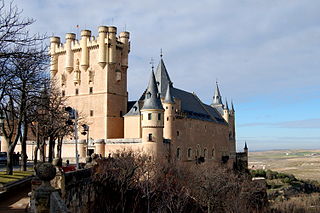
The Château de Chaumont is a castle in Chaumont-sur-Loire, Loir-et-Cher, France. The castle was founded in the 10th century by Odo I, Count of Blois. After Pierre d'Amboise rebelled against Louis XI, the king ordered the castle's destruction. Later in the 15th century Château de Chaumont was rebuilt by Charles I d'Amboise. Protected as a monument historique since 1840, the château was given into state ownership in 1938 and is now open to the public.
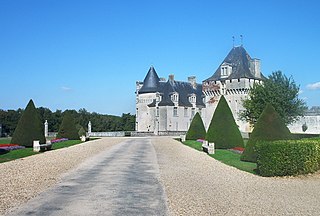
Château de la Roche Courbon is a large château, developed from an earlier castle, in the Charente-Maritime département of France. It is in the commune of Saint-Porchaire between Saintes and Rochefort. The château is privately owned, and classified as an historic monument. The garden is listed by the French Ministry of Culture as one of the Notable Gardens of France.

The Château de Biron is a castle in the valley of the Lède in the commune of Biron in the Dordogne département of France.
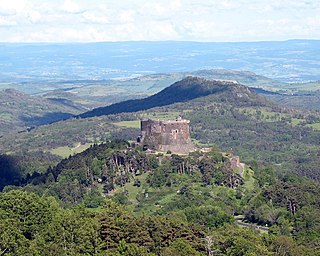
The Château de Murol is a castle overlooking the town of Murol in the département of Puy-de-Dôme in the Auvergne-Rhône-Alpes région, France.

The Château de Largoët, also known as the Tours d’Elven, is a medieval castle in Elven, in the Morbihan département of France, 13 km from Vannes.

The Château de l'Arthaudière is a castle, later converted into a château , in the commune of Saint-Bonnet-de-Chavagne in the Isère département of France. It was the former seigniory of the Arthauds and of the La Porte. The castle has been listed since 1991 as a monument historique by the French Ministry of Culture.
The Château de Thorens is a castle in the commune of Thorens-Glières in the Haute-Savoie département of France. It is accessible from the north-east of Annecy by a road of about 20 km, going up to the plateau of Glières. It is often confused with the Château de Sales that was formerly its neighbour of a few hundred metres; Sales was destroyed on the order of king Louis XIII in 1630. Since the liberation of France at the end of World War II, the castle has sometimes incorrectly been called Château de Thorens-Glières, based on the current name of the commune, but it has always rightly been just de Thorens.

The Château d'Ételan is a historical building in the commune of Saint-Maurice-d'Ételan in the Seine-Maritime département in Normandy, France. Situated on the right bank of the Seine between the Brotonne and Tancarville bridges, the Château d’Ételan commands a site overlooking the final loop of the river Seine.
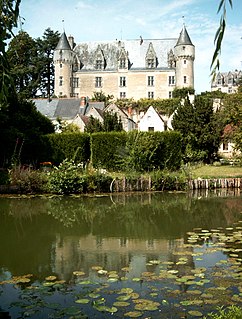
The Château de Montrésor is a medieval castle with a Renaissance mansion built in the grounds, located in the French village of Montrésor in the département of Indre-et-Loire.
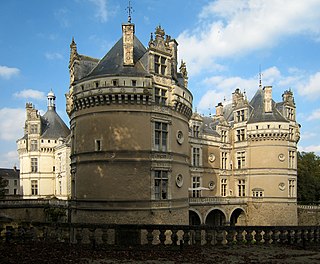
The Château du Lude is one of the many great châteaux of the Loire Valley in France. The château is situated in the commune of Le Lude in the Sarthe department in the region of Pays-de-la-Loire and stands at the crossroads of Anjou, Maine and Touraine. Le Lude is the most northerly château of the Loire Valley and one of the last important historic castles in France, still inhabited by the same family for the last 260 years. The château is testimony to four centuries of French architecture, as a stronghold transformed into an elegant house during the Renaissance and the 18th century. The monument is located in the valley of le Loir. Its gardens have evolved throughout the centuries. It is a harmonious combination of French design and an English-style landscape, with a rose garden, topiaries, a labyrinth and a botanical walk.

Château d'Ainay-le-Vieil is a 14th-century castle built on the grounds of an earlier 12th century castle in Ainay-le-Vieil, Cher, France. Château d'Ainay-le-Vieil is situated at an elevation of 168 meters. After having bought the castle from Jacques Cœur, Charles de Bigny built a pre-Renaissance Louis XII style chateaux from 1500 to 1505. The castle has been listed as a Monument historique since 1968 by the French Ministry of Culture. The castle, now part of Jacques Cœur's tourist route, has been nicknamed "the little Carcassonne" because of its circular shape. Today the castle is one of the best preserved fortresses of the 14th century.

The Château des Bories is a château at Antonne-et-Trigonant in Dordogne, Nouvelle-Aquitaine, France. The castle dates back to the late 15th and early 16th century. It has fortified towers, a monumental staircase and a dry moat. It is the home of the Lary de Latour family.

The Château de La Bâtie-Seyssel is a castle in the commune of Barby in the Savoie département of France.
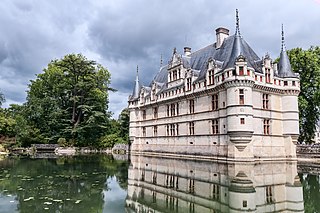
The Château d'Azay-le-Rideau is located in the town of Azay-le-Rideau in the French département of Indre-et-Loire. Built between 1518 and 1527, this château is considered one of the foremost examples of early French renaissance architecture. Set on an island in the middle of the Indre river, this picturesque château has become one of the most popular of the châteaux of the Loire valley.

The Château de Vizille is a castle in the French town of Vizille near Grenoble. It is one of the most prestigious and important castles of the Dauphiné Region. Traditionally since the 14th century the Dauphiné was the homeland of the inheritor of the French throne. Today the Château de Vizille houses the Musée de la Révolution française.

The Château d'Opme is an 11th-century castle, later converted to an elegant château, located in the commune of Romagnat, in the département of Puy-de-Dôme, in the Auvergne region of France, nine kilometers south of Clermont-Ferrand. Both the château and garden are classified as Historic Monuments by the French Ministry of Culture: the gardens are classified as a jardin remarquable.

Château-Dauphin is a medieval castle in the commune of Pontgibaud in the Puy-de-Dôme département of France.

The Château de Lacoste or La Coste is a ruined castle in the commune of Lacoste in the Vaucluse département of France.

The Château de Bélarga is a château constructed in the 17th century. Part of the building is from an earlier castle dating from the 14th and 15th centuries. It is located on the left bank of the Hérault River in the commune of Bélarga in the Hérault département of France.



